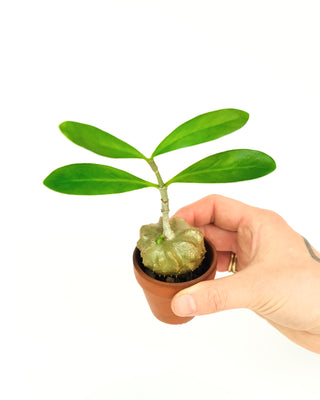Hydnophytum formicarum ssp. 'Horne', commonly known as the ant plant, is a fascinating and unique species of plant native to the tropical rainforests of Southeast Asia and northern Australia. It belongs to the Rubiaceae family and is renowned for its symbiotic relationship with ants. This epiphytic plant grows on tree trunks and branches in its native habitat, where it forms swollen, knobby structures known as caudices that serve as housing for ants. These caudices are often thick, tuber-like, and provide shelter and nourishment for the ants, while the ants, in turn, protect the plant from herbivores and help with the dispersal of its seeds. This mutualistic relationship is one of the plant’s most fascinating features.
The plant’s appearance is equally intriguing, with glossy, dark green, lance-shaped leaves that grow in a rosette pattern. The leaves have a leathery texture and provide a striking contrast to the unusual, knobby caudices. The plant produces small, white to pale yellow flowers that are relatively inconspicuous but still add to its charm. In the wild, Hydnophytum formicarum is typically found in the shady understory of rainforests, where it thrives in humid, warm conditions.
Hydnophytum formicarum is well-suited to indoor environments where humidity can be controlled. It thrives in bright, indirect light, as direct sunlight can scorch its leaves. It prefers high humidity and should be watered regularly, though the soil should be allowed to dry out slightly between waterings to prevent root rot. As an epiphyte, it prefers to be planted in a well-draining mix, such as one designed for orchids or bromeliads, which allows air to reach its roots and prevents waterlogging. It can be grown in a pot with good drainage or even mounted on a piece of wood or bark to mimic its natural growing conditions.
Hydnophytum formicarum ssp. 'Horne', commonly known as the ant plant, is a fascinating and unique species of plant native to the tropical rainforests of Southeast Asia and northern Australia. It belongs to the Rubiaceae family and is renowned for its symbiotic relationship with ants. This epiphytic plant grows on tree trunks and branches in its native habitat, where it forms swollen, knobby structures known as caudices that serve as housing for ants. These caudices are often thick, tuber-like, and provide shelter and nourishment for the ants, while the ants, in turn, protect the plant from herbivores and help with the dispersal of its seeds. This mutualistic relationship is one of the plant’s most fascinating features.
The plant’s appearance is equally intriguing, with glossy, dark green, lance-shaped leaves that grow in a rosette pattern. The leaves have a leathery texture and provide a striking contrast to the unusual, knobby caudices. The plant produces small, white to pale yellow flowers that are relatively inconspicuous but still add to its charm. In the wild, Hydnophytum formicarum is typically found in the shady understory of rainforests, where it thrives in humid, warm conditions.
Hydnophytum formicarum is well-suited to indoor environments where humidity can be controlled. It thrives in bright, indirect light, as direct sunlight can scorch its leaves. It prefers high humidity and should be watered regularly, though the soil should be allowed to dry out slightly between waterings to prevent root rot. As an epiphyte, it prefers to be planted in a well-draining mix, such as one designed for orchids or bromeliads, which allows air to reach its roots and prevents waterlogging. It can be grown in a pot with good drainage or even mounted on a piece of wood or bark to mimic its natural growing conditions.

